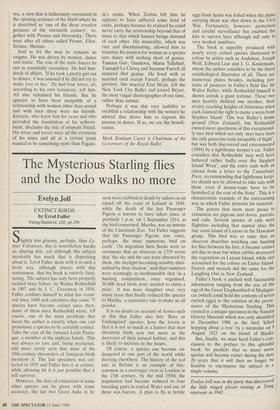The Mysterious Starling flies and the Dodo walks no more
Evelyn Jo11
EXTINCT BIRDS by Errol Fuller
VikinglRainbird, £20, pp.256
Slightly less gloomy, perhaps, than Ex- tinct Volcanoes, this is nonetheless hardly an alluring title; yet although this subject inevitably has much that is depresing about it, Errol Fuller deals with it in such a lively way, although always with due seriousness, that his book is entirely fasci- nating. The subject has only been properly tackled twice before: by Walter Rothschild in 1907 and by J. C. Greenway in 1958. ' Fuller confines himself to what has occur- red since 1600 and calculates that some 75 species have become extinct since then, many of them since Rothschild wrote. Of course, one of the main problems that faced the author is exactly when one can pronounce a species to be certainly extinct. Take the case of the Jamaica Least Paura- que, a member of the nightjar family. This was always so rare and, being nocturnal, still more rarely seen that none of the 19th-century chroniclers of Jamaican birds mentions it. The last specimen was col- lected in 1859 and Fuller lists it as extinct, while allowing tht it is just possible that it still survives.
However, the date of extinction of some other species can be given with some accuracy: the last two Great Auks to be
seen were clubbed to death by sailors on an island off the coast of Iceland in 1844, while the death of the last Passenger Pigeon is known to have taken place at precisely 1 p.m. on 1 September 1914, as the bird concerned, Martha, was an inmate of the Cincinnati Zoo. Yet Fuller suggests that the Passenger Pigeon, was 'once, perhaps, the most numerous bird on earth'. On migration their flocks were so enormous that an observer in 1759 wrote that 'the sky and the sun were obscured by them, the daylight becoming sensibly dimi- nished by their shadow', and their numbers were seemingly so inexhaustible that 'in a hunting competition, once organised, 30,000 dead birds were needed to claim a prize'. It was mass slaughter over very many years that finally reduced the species to Martha, a cautionary tale to make us all ponder.
It is no doubt on account of stories such as this that Fuller also lists 'Rare or Endangered' species; here the lesson is that it is not so much as a hunter that man threatens birds now but more as the destroyer of their natural habitat, and this is likely to increase in the future.
Of course, a species can become en- dangered in one part of the world while thriving elsewhere. The history of the red kite in Britain is an example of this: common as a scavenger even in London in the 15th century, by the mid 1930s the population had become reduced to four breeding pairs in central Wales and one of these was barren. A plan to fly in fertile eggs from Spain was foiled when the plane carrying them was shot down in the Civil War. Fortunately, however, protection and careful surveillance has enabled the kite to survive here although still only in very modest numbers.
The book is superbly produced with nearly every extinct species illustrated in colour by artists such as Audubon, Joseph Wolf, Edward Lear and J. G. Keulemans, whom the author considers to be the finest ornithological illustrator of all. There are numerous plates besides, including por- traits of pioneers in Fuller's field like Sir Walter Buller, while Rothschild himself is shown astride a giant tortoise. These two men heartily disliked one another, their rivalry reaching heights of bitterness when each claimed the right to name a wren from Stephen Island. This was Buller's home ground (New Zealand), but Rothschild owned more specimens of this exceptional- ly rare bird which not only 'may have been the only passerine truly incapable of flight', but was both discovered and exterminated (1894) by a lighthouse keeper's cat. Fuller considers that Rothschild 'may well have behaved rather badly over the Stephen Island Wren', and the entry ends with an extract from a letter to the Canterbury Press, recommending that lighthouse keep- ers should not be allowed to take cats with them 'even if mouse-traps have to be furnished at the cost of the State'. This is a characteristic example of the entertaining way in which Fuller presents his material.
The genera that seem most prone to extinction are pigeons and doves, parrots, and rails. Several species of rails were flightless including that named after the tiny coral island of Laysan in the Hawaiian group. This bird was so tame that an observer describes watching one hunting for flies between his feet; it became extinct not due to man but when rabbits destroyed the vegetation on Laysan Island, while rats accounted for the colony on Easter Island. Ferrets and weasels did the same for the Laughing Owl in New Zealand.
Fuller's book is packed with fascinating information ranging from the size of the egg of the Great Elephantbird of Madagas- car (which could hold the contents of seven ostrich eggs) to the solution of the prove- nance of the Mysterious Starling. This existed in a unique specimen in the Natural History Museum which was only identified in December 1986 as the bird 'killed hopping about a tree' by a naturalist on 9 August 1825 on the island of Mauke.
But, finally, we must heed Fuller's con- clusion to the preface to this splendid book: he predicts that so many more species will become exinct during the next 20 years that it will then no longer be feasible to encompass the subject in a single volume.
Evelyn loll was in the party that discovered the little ringed plover nesting at Tring reservoir in 1943.


































































 Previous page
Previous page